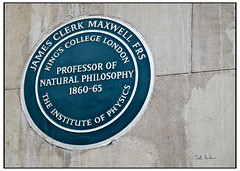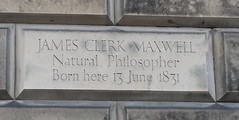James Clerk Maxwell


James Clerk Maxwell
(1831-1879)
Commemorated on 7 plaques
James Clerk Maxwell the eminent physicist lived in this house from 1856 to 1860 whilst he was Professor of Natural Philosophy at the University of Aberdeen
131 Union Street, Back Wynd Steps, Aberdeen, United Kingdom where they lived
Cavendish Laboratory 1874-1974 Established by the Duke of Devonshire and extended by Lord Rayleigh (1908) and Lord Austin (1940), the Cavendish Laboratory housed the Department of Physics from the time of the first Cavendish Professor, James Clerk Maxwell, until its move to new laboratories in West Cambridge
Free School Lane, Cambridge, United Kingdom where they was
James Clerk Maxwell FRS King's College London Professor of Natural Philosophy 1860-65
King's College London, Strand, WC2R 2LS, London, United Kingdom where they was Professor of Natural Philosophy
James Clerk Maxwell (1831-1879) physicist lived here
16 Palace Gardens Terrace, Kensington, W8, London, United Kingdom where they lived
James Clerk Maxwell Natural Philosopher Born here 13 June 1831
14 India Street, Edinburgh, United Kingdom where they was born (1831)
[Mathematical equations in memory of James Clerk Maxwell]
, Edinburgh, United Kingdom where they worked near
James Clerk Maxwell 1831-1879 Pioneering physicist of electromagnetic radiation, molecular science and colourimetry lived in this building from 1856 to 1860 while Professor at Marischal College, later the University of Aberdeen
Back Wynd Stairs, off Union Street, Aberdeen, United Kingdom where they lived (1856-1860)




_physicist_lived_here.jpg?width=250)


